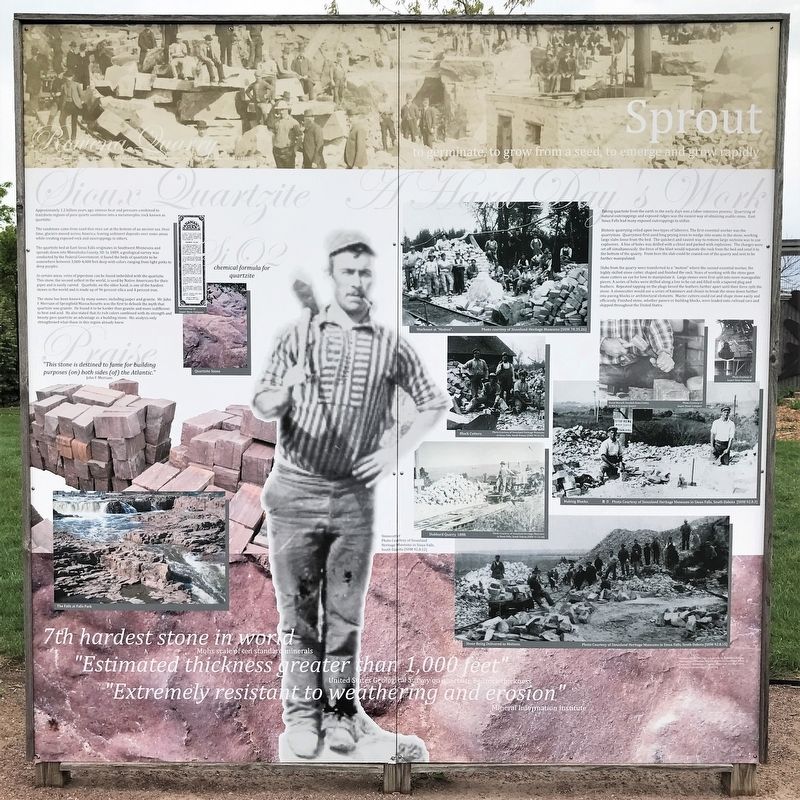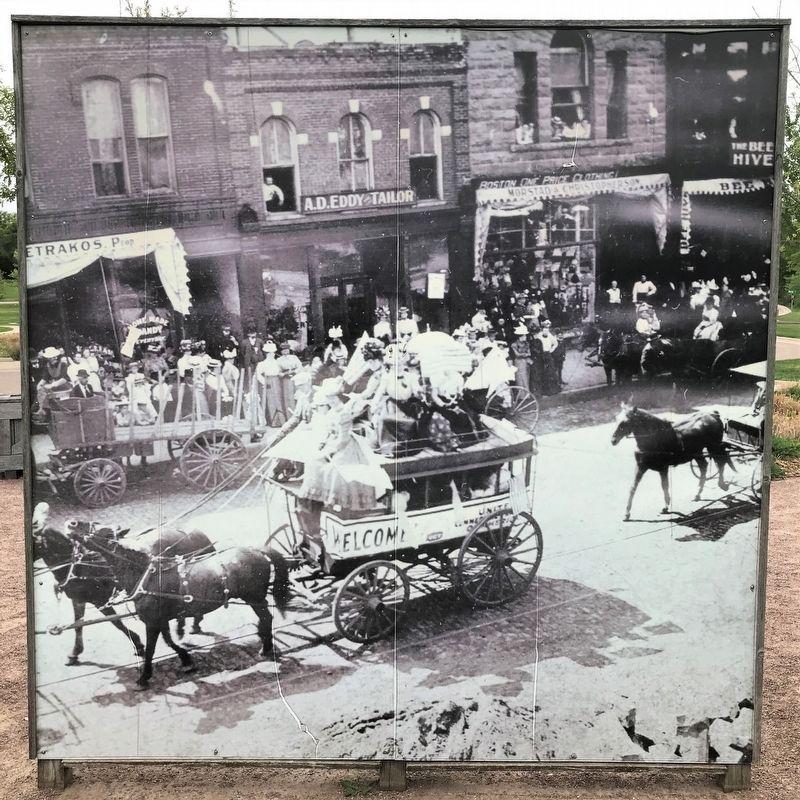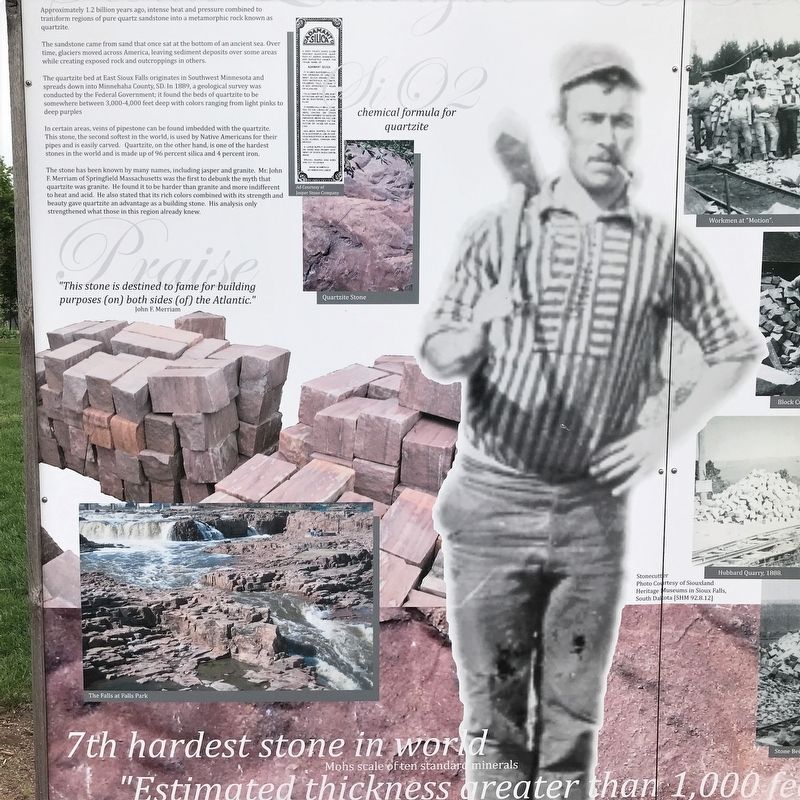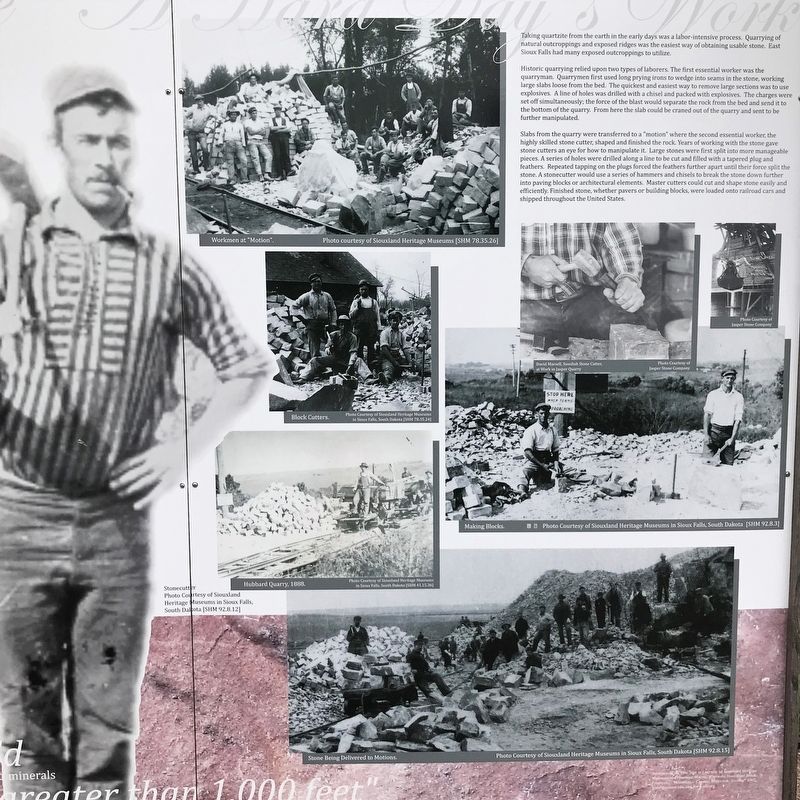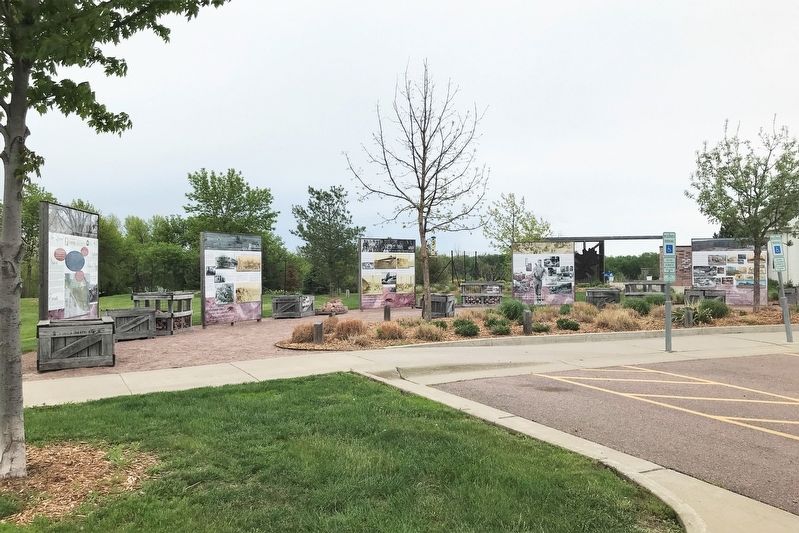Sioux Falls in Minnehaha County, South Dakota — The American Midwest (Upper Plains)
Sprout
header:
Rowena Quarry
The Neighboring Rowena Quarry, 1890. Photo Courtesy of Siouxland Heritage Museums in Sioux Falls, South Dakota [SHM 41.15.36]
Sioux Quartzite
Approximately 1.2 billion years ago, intense heat and pressure combined to transform regions of pure quartz sandstone into a metamorphic rock known as quartzite.
The sandstone came from sand that once sat at the bottom of an ancient sea. Over time, glaciers moved across America, leaving sediment deposits over some areas while creating exposed rock and outcroppings in others.
The quartzite bed at East Sioux Falls originates in Southwest Minnesota and spreads down into Minnehaha County, SD. In 1889, a geological survey was conducted by the Federal Government; it found the beds of quartzite to be somewhere between 3,000-4,000 feet deep with colors ranging from light pinks to deep purples
In certain areas, veins of pipestone can be found imbedded with the quartzite. This stone, the second softest in the world, is used by Native Americans for their pipes and is easily carved. Quartzite, on the other hand, is one of the hardest stones in the world and is made up of 96 percent silica and 4 percent iron.
The stone has been known by many names, including jasper and granite. Mr. John F. Merriam of Springfield Massachusetts was the first to debunk the myth that quartzite was granite. He found it to be harder than granite and more indifferent to heat and acid. He also stated that its rich colors combined with its strength and beauty gave quartzite an advantage as a building stone. His analysis only strengthened what those in this region already knew.
SiO2
chemical formula for quartzite
"Adamant Silica" ad:
A very tough, hard, close grained quartzite quarried at Jasper, Minnesota, and marketed under the trade name of
Adamant Silica
It is used successfully in the grinding of ores cement, silica, enamel pottery materials, dolomite, feldspar, talc, gypsum. It is not affected by acids or alkalies.
Its ultimate failure is by attrition, not by fracture or by shattering, as with flint.
It is especially well adapted to the lining of launders, chutes, or other places exposed to hard or abrasive wear or for use in places exposed to the action of acids or alkalies.
Has been shipped to and is in successful use in various industries in 38 states also Alaska, Canada and Mexico.
A large supply is carried on hand and prompt shipment of stock sizes can be made.
Special shapes and sizes are cut to order.
Made in America by American Labor
Ad Courtesy of Jasper Stone Company
photo:
Quartzite Stone
Praise
"This stone is destined to fame for building purposes (on) both sides (of) the Atlantic."
John F. Merriam
photo:
The Falls at Falls Park
A Hard Day's Work
Taking quartzite from the earth in the early days was a labor-intensive process. Quarrying of natural outcroppings and exposed ridges was the easiest way of obtaining usable stone. East Sioux Falls had many exposed outcroppings to utilize.
Historic quarrying relied upon two types of laborers. The first essential worker was the quarryman. Quarrymen first used long prying irons to wedge into seams in the stone, working large slabs loose from the bed. The quickest and easiest way to remove large sections was to use explosives. A line of holes was drilled with a chisel and packed with explosives. The charges were set off simultaneously; the force of the blast would separate the rock from the bed and send it to the bottom of the quarry. From here the slab could be craned out of the quarry and sent to be further manipulated.
Slabs from the quarry were transferred to a "motion" where the second essential worker, the highly skilled stone cutter, shaped and finished the rock. Years of working with the stone gave stone cutters an eye for how to manipulate it. Large stones were first split into more manageable pieces. A series of holes were drilled along a line to be cut and filled with a tapered plug and feathers. Repeated tapping on the plugs forced the feathers further apart until their force split the stone. A stonecutter would use a series of hammers and chisels to break the stone down further into paving blocks or architectural elements. Master cutters could cut and shape stone easily and efficiently. Finished stone, whether pavers or building blocks, were loaded onto railroad cars and shipped throughout the United States.
photos:
Workmen at "Motion".
Photo courtesy of Siouxland Heritage Museums [SHM 78.35.26]
Block Cutters.
Photo Courtesy of Siouxland Heritage Museums in Sioux Falls, South Dakota [SHM 78.35.24]
Hubbard Quarry, 1888.
Photo Courtesy of Siouxland Heritage Museums in Sioux Falls, South Dakota [SHM 41.15.36]
David Marsell, Swedish Stone Cutter, at Work in Jasper Quarry
Photo Courtesy of Jasper Stone Company
Photo Courtesy of Jasper Stone Company
Making Blocks.
Photo Courtesy of Siouxland Heritage Museums in Sioux Falls, South Dakota [SHM 92.8.3]
Stonecutter
Photo Courtesy of Siouxland Heritage Museums in Sioux Falls, South Dakota [SHM 92.8.12]
Stone Being Delivered to Motions.
Photo Courtesy of Siouxland Heritage Museums in Sioux Falls, South Dakota [SHM 92.8.15]
7th hardest stone in world
Mohs scale of ten standard minerals
"Estimated thickness greater than 1,000 feet"
United States Survey on quartzite bedrock thickness
"Extremely resistant to weathering and erosion"
Mineral Information Institute
Information in This Sign is Courtesy of Siouxland Heritage Museums and Fanebust, Wayne. Where the Sioux River Bends. Freeman: Minnehaha County Historical Society, 1985. www.geo.umn.edu, and www.mh.org.
Topics. This historical marker is listed in this topic list: Industry & Commerce. A significant historical year for this entry is 1889.
Location. 43° 31.632′ N, 96° 36.373′ W. Marker is in Sioux Falls, South Dakota, in Minnehaha County. Marker is on South Perry Place, 0.1 miles north of State Highway 42, on the right when traveling north. Located at the Mary Jo Wegner Arboretum & East Sioux Falls Historic Site. Touch for map. Marker is at or near this postal address: 1900 S Perry Pl, Sioux Falls SD 57110, United States of America. Touch for directions.
Other nearby markers. At least 8 other markers are within walking distance of this marker. Disperse (here, next to this marker); Wilt (here, next to this marker); fruit (a few steps from this marker); bud (a few steps from this marker); Flourish (a few steps from this marker); Seed (a few steps from this marker); vegetate (within shouting distance of this marker); unearth (within shouting distance of this marker). Touch for a list and map of all markers in Sioux Falls.
Credits. This page was last revised on June 2, 2022. It was originally submitted on June 1, 2022. This page has been viewed 93 times since then and 15 times this year. Photos: 1, 2, 3, 4, 5. submitted on June 1, 2022.
